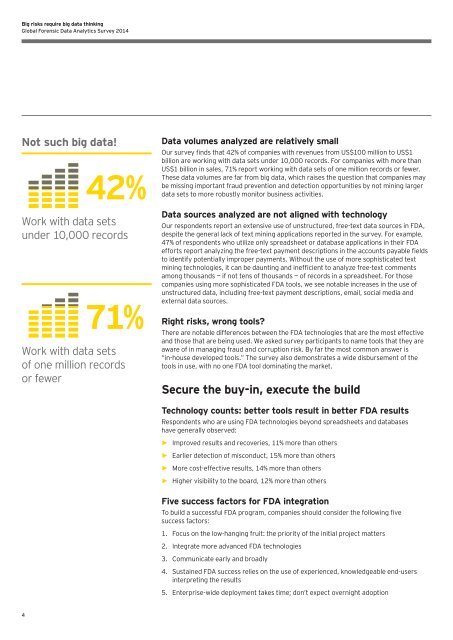EY-Global-Forensic-Data-Analytics-Survey-2014
EY-Global-Forensic-Data-Analytics-Survey-2014
EY-Global-Forensic-Data-Analytics-Survey-2014
Create successful ePaper yourself
Turn your PDF publications into a flip-book with our unique Google optimized e-Paper software.
Big risks require big data thinking<br />
<strong>Global</strong> <strong>Forensic</strong> <strong>Data</strong> <strong>Analytics</strong> <strong>Survey</strong> <strong>2014</strong><br />
Not such big data!<br />
42%<br />
Work with data sets<br />
under 10,000 records<br />
71%<br />
Work with data sets<br />
of one million records<br />
or fewer<br />
<strong>Data</strong> volumes analyzed are relatively small<br />
Our survey finds that 42% of companies with revenues from US$100 million to US$1<br />
billion are working with data sets under 10,000 records. For companies with more than<br />
US$1 billion in sales, 71% report working with data sets of one million records or fewer.<br />
These data volumes are far from big data, which raises the question that companies may<br />
be missing important fraud prevention and detection opportunities by not mining larger<br />
data sets to more robustly monitor business activities.<br />
<strong>Data</strong> sources analyzed are not aligned with technology<br />
Our respondents report an extensive use of unstructured, free-text data sources in FDA,<br />
despite the general lack of text mining applications reported in the survey. For example,<br />
47% of respondents who utilize only spreadsheet or database applications in their FDA<br />
efforts report analyzing the free-text payment descriptions in the accounts payable fields<br />
to identify potentially improper payments. Without the use of more sophisticated text<br />
mining technologies, it can be daunting and inefficient to analyze free-text comments<br />
among thousands — if not tens of thousands — of records in a spreadsheet. For those<br />
companies using more sophisticated FDA tools, we see notable increases in the use of<br />
unstructured data, including free-text payment descriptions, email, social media and<br />
external data sources.<br />
Right risks, wrong tools?<br />
There are notable differences between the FDA technologies that are the most effective<br />
and those that are being used. We asked survey participants to name tools that they are<br />
aware of in managing fraud and corruption risk. By far the most common answer is<br />
“in-house developed tools.” The survey also demonstrates a wide disbursement of the<br />
tools in use, with no one FDA tool dominating the market.<br />
Secure the buy-in, execute the build<br />
Technology counts: better tools result in better FDA results<br />
Respondents who are using FDA technologies beyond spreadsheets and databases<br />
have generally observed:<br />
►►<br />
Improved results and recoveries, 11% more than others<br />
►►<br />
Earlier detection of misconduct, 15% more than others<br />
►►<br />
More cost-effective results, 14% more than others<br />
►►<br />
Higher visibility to the board, 12% more than others<br />
Five success factors for FDA integration<br />
To build a successful FDA program, companies should consider the following five<br />
success factors:<br />
1. Focus on the low-hanging fruit: the priority of the initial project matters<br />
2. Integrate more advanced FDA technologies<br />
3. Communicate early and broadly<br />
4. Sustained FDA success relies on the use of experienced, knowledgeable end-users<br />
interpreting the results<br />
5. Enterprise-wide deployment takes time; don’t expect overnight adoption<br />
4


